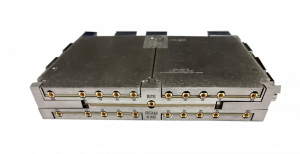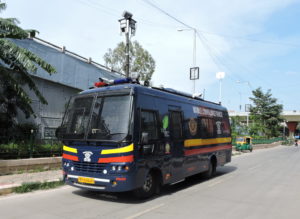RF Card for Data Acquisition
Introduction
The RF Acquisition Card is an RF front-end for the RADAR Receiver system which receives RF signals from different RADAR systems & passes them to the RF Data Acquisition Unit for Direct Sampling of L-band and X-band. These modules are ideal for applications such as Phased Array Radars, Electronic Warfare, Signal Intelligence (SIGINT) Systems, Multi-band Diversity Digital Receivers, Satellite Communication, etc.
 This case study showcases Mistral’s expertise in design and development of a pluggable, VPX RF Acquisition Card to capture RF signals in 1GHz to 6GHz range, channelize to four different bands and provide the requisite RF output for further processing.
This case study showcases Mistral’s expertise in design and development of a pluggable, VPX RF Acquisition Card to capture RF signals in 1GHz to 6GHz range, channelize to four different bands and provide the requisite RF output for further processing.
The Customer
The customer is a leading Defence Research and Development Organization in India. The customer is involved in the research and development of avionics systems for Indian Defense.
The Requirement
The customer approached Mistral to develop an RF Acquisition Card, a 6U form-factor, conduction-cooled module that adhered to VITA 46 standard, for one of the Avionics projects. The module had to capture the incoming RF signals and pass it to the RF Data Acquisition Unit for further processing. Mistral had to design and develop the RF Acquisition Card and perform ESS tests before delivering the product to the customer. This was a built-to-spec project and the preliminary design of the card was provided by the customer. Mistral had to conduct a feasibility study of the design, and any changes/improvements in the design had to be discussed and finalized with the customer. The RF Acquisition Card development involved:
- Schematic capture as per the final design approved by the customer
- PCB layout for the card and test jig
- Meet Group A certification standards and the assembly procedure as per IPC standard
- High-speed signal simulation and analysis
- Signal integrity, power integrity, and thermal analysis
- Fabrication and bare board testing of the fabricated card and assembly as per IPC standard
- FPGA firmware and software development for all hardware interfaces
- Development of test jig for the card to test all the peripherals
- Acceptance test procedure for standalone testing of the card with test jig and host PC
- Wedge lock mechanism to mount the RF Acquisition Card.
The module had to adhere to stringent specifications with respect to:
- Sub-band switching time
- Dynamic range
- System noise figure
- Return loss
- Isolation between the channels
- Harmonics of each channel
- All filter rejection
- Overall path gain
- Gain ripple over the band
- Total power consumption.
Solution Provided
Mistral developed an RF Acquisition Card, meeting all the requirements defined by the customer. The 6U VPX based conduction-cooled module design included Hardware design, Firmware and GUI development to control the switching and attenuation of RF channels.
The RF Acquisition Card consists of four RF modules and each RF module channelizes the 5GHz Bandwidth RF input signal into multiple bands. The 5GHz bandwidth RF input signal is further divided into four major bands and each band is further divided into three user-selectable sub-bands. Each RF module connects to one antenna and produces four output bands.
Features
RF Acquisition Card is built around Intel FPGA. The key features of the module include:
- Four RF inputs
- Sixteen RF Outputs
- Operating supply: +12V
- 0 0 Operating Temperature range: -40o C to 85 o C
Software and Firmware
ATP software: Mistral developed software for the Acceptance Test Plan to conduct functional tests on the card.
FPGA firmware: Mistral provided firmware for all switches, attenuation controls and BITE section configuration along with peripheral interface configuration codes.
Test GUI: Mistral developed a GUI, designed to test and control all the channels of the card.
Functional Tests
Functional tests were carried out to test and validate the functionality of each component of the card. The test procedure includes the following checks.
- Gain and Flatness Measuring of each channel
- Switching speed Measurement
- All Filter Rejection Measurement
- System Noise figure Measurement
- Isolation between the channels
- Return Loss and Power Consumption of the system.
Environmental Stress Screening
Mistral performed ESS as per MIL-STD-810G. The card was subjected to ESS as per the following tests, specification and sequence.
- Power Burn-in Test
- Pre-thermal random vibration
- Thermal cycling
- Post-thermal random vibration.
Read the full case study to know about the challenges, achievements and benefits of RF Acquisition Card.





